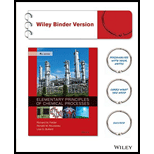
Concept explainers
(a)
Interpretation:
The volume of the API in mL to be sprayed for the patients with specified mass is to be calculated. Also, number of drops in every prescribed dose of the drug is to be calculated.
Concept introduction:
Mass of the drug
Number of moles
Here,
Molarity
Here,
Number of drops
Here,
Volume of a sphere
Here,
(b)
Interpretation:
The formula for the volume,
Concept introduction:
Weight
Here,
Mass of the drug
Number of moles
Here,
Molarity
Here,
(c)
Interpretation:
For a sphere of radius ‘r’, its surface-to-volume ratio is to be calculated. Also, the surface area of the sphere for the specified volume and radius is to be determined.
Concept introduction:
Volume of a sphere
Here,
Surface area of a sphere
Here,
Want to see the full answer?
Check out a sample textbook solution
Chapter 3 Solutions
Elementary Principles of Chemical Processes, Binder Ready Version
 Introduction to Chemical Engineering Thermodynami...Chemical EngineeringISBN:9781259696527Author:J.M. Smith Termodinamica en ingenieria quimica, Hendrick C Van Ness, Michael Abbott, Mark SwihartPublisher:McGraw-Hill Education
Introduction to Chemical Engineering Thermodynami...Chemical EngineeringISBN:9781259696527Author:J.M. Smith Termodinamica en ingenieria quimica, Hendrick C Van Ness, Michael Abbott, Mark SwihartPublisher:McGraw-Hill Education Elementary Principles of Chemical Processes, Bind...Chemical EngineeringISBN:9781118431221Author:Richard M. Felder, Ronald W. Rousseau, Lisa G. BullardPublisher:WILEY
Elementary Principles of Chemical Processes, Bind...Chemical EngineeringISBN:9781118431221Author:Richard M. Felder, Ronald W. Rousseau, Lisa G. BullardPublisher:WILEY Elements of Chemical Reaction Engineering (5th Ed...Chemical EngineeringISBN:9780133887518Author:H. Scott FoglerPublisher:Prentice Hall
Elements of Chemical Reaction Engineering (5th Ed...Chemical EngineeringISBN:9780133887518Author:H. Scott FoglerPublisher:Prentice Hall
 Industrial Plastics: Theory and ApplicationsChemical EngineeringISBN:9781285061238Author:Lokensgard, ErikPublisher:Delmar Cengage Learning
Industrial Plastics: Theory and ApplicationsChemical EngineeringISBN:9781285061238Author:Lokensgard, ErikPublisher:Delmar Cengage Learning Unit Operations of Chemical EngineeringChemical EngineeringISBN:9780072848236Author:Warren McCabe, Julian C. Smith, Peter HarriottPublisher:McGraw-Hill Companies, The
Unit Operations of Chemical EngineeringChemical EngineeringISBN:9780072848236Author:Warren McCabe, Julian C. Smith, Peter HarriottPublisher:McGraw-Hill Companies, The





